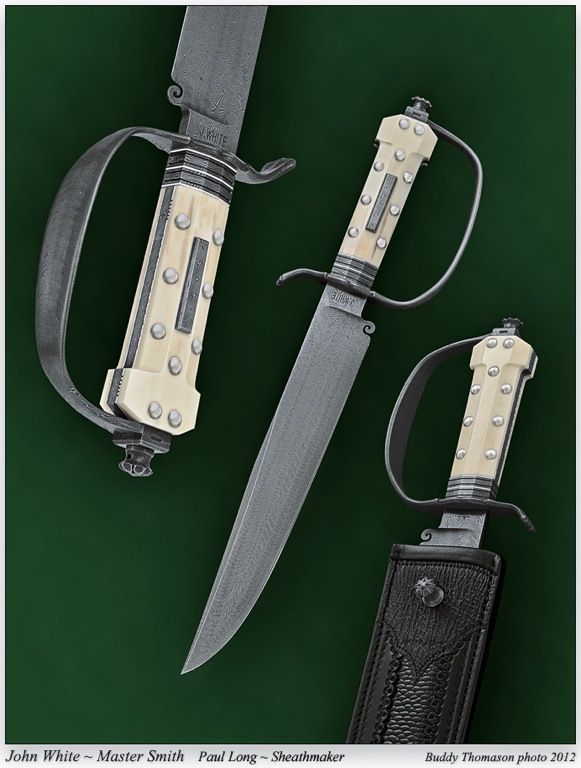I meant to ask Jim about this during the Handles & Guards class, but I forgot.
I mostly work with damascus that I make for blades, and I'm starting to make guard and fitting stock also. I'm well aware that hardened damascus etches better, but what I'm not clear is what procedure is best for machining hardened fittings.
Most importantly, are you guys slotting guards before or after hardening? If before, how do you maintain tolerances for press fit guards, considering the concerns for dimension changes, warp, scale, etc? Unless perhaps using salt or packet to harden. If after, which is what I'm presuming is the case, are you drawing the temper back really low or simply relying on carbide end mills to handle a high hardness?
My mill's max spindle speed is 1400, which calculates to an extremely low sfpm for a 1/8 or 3/16 carbide cutter, which obviously translate to much less than optimal cutting conditions, so before I start trashing tooling and stock, I was hoping for some clarity. <img src=' http://www.americanbladesmith.com/ipboard/public/style_emoticons//wink.gi f' class='bbc_emoticon' alt=';)' />
Thanks all!
Javan,
I've been hardening damascus fittings for a while. I do all machining, fitting, and sanding before hardening.
If you have correctly normalized and semi-spheroidally annealed, you should have no warping or significant dimension changes in the relatively small fittings.
Larger and more complex fittings like D-Guard bows are austenized in an electric digital oven for even heating and soaking, and for these, I'm using Brownell's ATP-641 anti-scale. I have to re-sand, starting about 600-800 grit, after tempering.
For simple fittings like collars, etc, I just forge heat in a reducing atmosphere; there's no scale formed at a short heat time, and I just re-sand with 1000 grit.
(Steve Culver has put an Argon injector on his oven.)
Try hardening on some simple fittings. It's easier than it seems.
John
P.S. If I can do it, I'm about to post up pics of a damascus Dogbone pair, Dagger and Bowie, with all hardened damascus fittings.
Ok John, thanks so much for the response.
So if you slot a damascus guard before hardening, do you still mill to within a few thou? Do you have to clean up the slot after HT, and if so, could you elaborate on the procedure? Jim got me pretty hooked on a "perfect" press fit only guard, although I concede that damascus is a bit more forgiving on the marriage of guard to ricasso and yet at the same time creates it's own complexities where patterns dont sync.
Sorry for all the questions and thanks for indulging my ingorance. This is the part of knifemaking I strugle with the most, and also the part I feel is most important to perfect.
Javan
You'll probably want to temper your fittings to a spring temper, maybe 600F for 1080/15n20, but no other changes to your techniques should be required., as long as you are properly preparing your damascus for heat treating.
For dimensional stability, I recommend controlled temperature normalizing, annealing, and austenizing. Either a full spheroidal anneal, or the practical alternative, soaking at, say, 1200F for 1 hour really helps.
Just try hardening and tempering one of your already "press-fitted" guards. If you're working with a compact, "chunky" guard, where you're not really worried about warping, just run some stainless wire thru the slot, grab it with the tongs, stick it in the forge with a reducing atmosphere, and plunk it in your Parks 50. Sand it back out with 1000 grit, and temper. Re-sand and etch. You probably wont have to do more than touch up the slot with your file to get off burned-on oil., if the steel was properly prepared.
Just try it!
More complex fittings, like shaped guards and handle frames, will probably be best austenized in a digital oven with anti-scale. 800-1000 grit sanding won't change dimensions significantly.
Most of my knives are "take-down" pieces with shouldered tangs, and are fitted to "finger tightness." You may want to research and consider "take-down" construction as you begin to make higher end, all damascus knives. Owners appreciate the ability to restore both user and collector pieces to original condition. Check out WIP's by Karl Anderson on this subject. I also have WIP's on CKCA and Bladeforums.
Here's a pic. All the damascus, blade, d-guard, collars,frames, caps, and finial, are heat-treated, tempered, and etched. No changes in dimension or alignment were noted.
Go for it.
John

Thank you John, so very much.

